Summer rose cuttings in July – the optimal period for propagating these beautiful plants. Green, fully leafed, and flowering bushes produce abundant young growth and allow you to preserve varietal characteristics. In this article, we will explain in detail whether it is possible to take rose cuttings in summer, which methods gardeners use for rooting cuttings, and how to propagate them in open ground.
Table of contents
Is It Worth Propagating Roses from Cuttings in Summer (July)?
Summer is the best time for rose cuttings. It allows you to create young, healthy bushes and maintain the quality of the variety. Green cuttings, which appear in abundance on mother bushes in summer, are ideal for this purpose.
There are no difficulties in selection, as there is plenty of material available. During summer, cuttings root quickly and gain strength before the cold weather arrives, ensuring they survive winter without losses.
Advantages and Disadvantages
Summer rose cuttings have several advantages over grafting:
- young bushes do not produce root suckers;
- any variety can be propagated, even roses from a gifted bouquet;
- easy to obtain planting material;
- cuttings produce longer-lived bushes than grafted ones.
The main drawback is that young bushes require reliable winter protection.
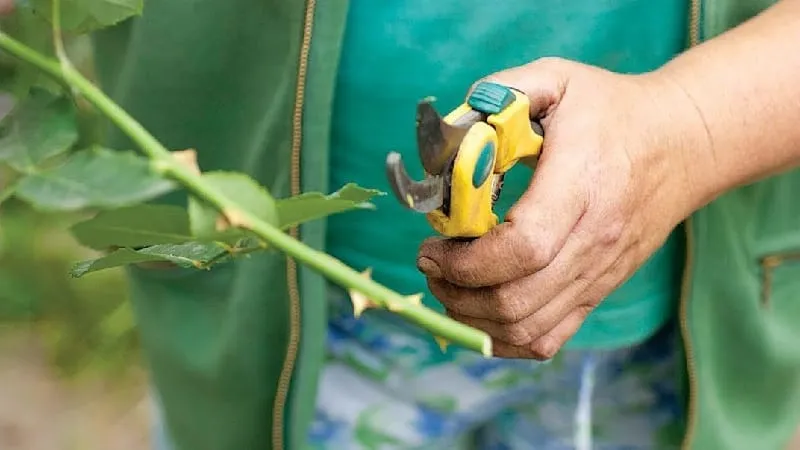
Optimal Timing for the Procedure
Rose cuttings are best taken in July – before and during flowering. In regions with hot, long summers, the procedure can be extended until mid-August.
Favorable Days According to the Lunar Calendar
Experienced gardeners recommend taking and rooting cuttings during the waxing Moon.
Basic Rules for Taking Cuttings
Choose young stems with bud initials. To determine the age of a shoot, try breaking off a few thorns: if they come off easily, the material is suitable.
A common mistake is selecting stems that are too old or thin (over 5 mm in diameter). Such material roots poorly.
Select the part of the shoot near the base. It should have 3-4 buds facing different directions. The lower cut is made at a sharp angle between the thorn and the bud, 2-3 cm below it. The upper cut is made no more than 1 cm above the bud. It can be straight or angled, as this does not affect rooting. Ensure the cut is smooth and clean using sharp pruning shears.
Partially trim the buds, especially the lower one. Removing them completely deprives the cutting of nutrients. Only leaf trimming is allowed instead of removing leafy shoots.
Plant cuttings immediately after cutting. Prolonged exposure to air may dry them out.
Step-by-Step Propagation Guide
Early morning is the best time to take cuttings, as the bushes are full of moisture. Disinfect pruning shears or a knife with rubbing alcohol, a copper sulfate solution, or potassium permanganate, then cut selected branches into 12-15 cm sections. Take them from the middle part of the stem with 3-4 healthy buds. Remove leaves entirely or trim them by 1/3 to retain moisture. Thorns should also be carefully removed.
Note. Overgrown green stems without buds are unsuitable for summer rose cuttings.
After cutting, soak the material in a solution of "Clonex," "RootBoost," "Hormodin," or "Rhizopon" to stimulate root growth. With this treatment, roots appear in 2 weeks; in plain water, it takes a month. For natural stimulation, use a folk remedy: 20 drops of aloe vera juice or 1 tsp honey per 250 ml water.
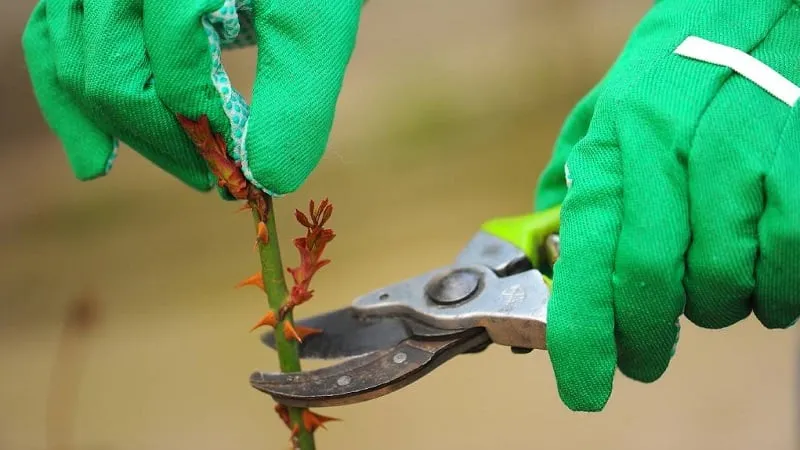
Preparing the Planting Site
Before planting rooted cuttings, select a suitable location and prepare the soil. Roses thrive in fertile soil and partially shaded areas.
Young plants need essential nutrients and protection from intense sun. Experts recommend planting cuttings under the shade of trees or tall shrubs.
Loosen the soil, remove weeds, and add a 10 cm layer of humus-rich soil. Top with 3-5 cm of a 1:1 mix of river sand and peat.
Important! Avoid compost and fresh manure when planting cuttings. These are suitable for mature plants but may cause rot in young ones.
Plant cuttings 1.5-2 cm deep. Deeper planting slows rooting. Cover them with plastic bottles or glass jars to create a greenhouse effect. Keep the soil moist throughout summer, watering between covers.
Rooting Methods for Cuttings
Gardeners use several methods to root rose cuttings: in water, soil, potatoes, plastic bags, the burrito method, and the Trancault method.
In Water
Place 1-2 cuttings in transparent plastic or glass containers (200 ml). Add 2-3 cm of water and a rooting stimulant. Place in bright, indirect light. Top up water as needed.
Once roots appear, transplant into pots with rose-specific soil. This method is labor-intensive and has a low success rate.
In Soil
Fill an 8-10 cm pot with rose soil, make a 4 cm hole, and add sterilized vermiculite or sand to prevent rot.
Dip the cutting tip in dry rooting hormone, plant, and cover with a cut plastic bottle. Ventilate occasionally and water. New leaves indicate successful rooting. Remove the cover and mist cuttings 2-3 times daily. Repot as roots grow.
In Potatoes
Potato rooting is highly effective. Starch and nutrients promote root growth. Use medium-sized, disease-free potatoes. Soak them in a fungicide ("Signum," "Switch," "Teldor"), then remove all eyes.
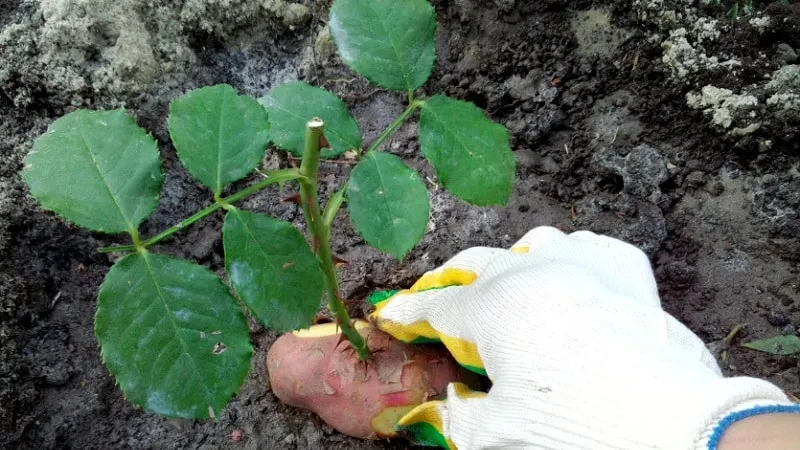
Treat cuttings with potassium permanganate, then soak in aloe vera juice for 12 hours to preserve freshness. Alternatively, use rooting hormones.
Cut holes in potatoes (one per cutting). Seal the top cut with wax.
Fill pots with nutrient-rich soil, place the potato inside, and plant. Alternatively, use black bags hung near a window. Buds appear in 2-3 weeks. Water every 2-3 days; add sugar (1 tbsp per 250 ml water) weekly for extra carbohydrates.
In a Plastic Bag
Fill sturdy plastic bags with rose soil or moss (soaked in water with aloe vera juice, 9:1 ratio). Insert cuttings, inflate the bag, tie it, and hang it near a window. The greenhouse effect encourages root growth.
Burrito Method
This gardener-invented method involves wrapping cuttings in damp newspaper or paper, placing them in a black plastic bag, and storing them in a warm, dark place. Check periodically to prevent rot. Rewet if needed. Roots appear in 2 weeks, even without hormones.
Trancault Method
This method maximizes starch accumulation in leaves. Take cuttings after flowering, removing small leaves and wilted buds. New buds at the stem base indicate readiness. Cut 20 cm sections and plant 5-7 per hole at a 45° angle. Cover with plastic. Water and aerate soil regularly.
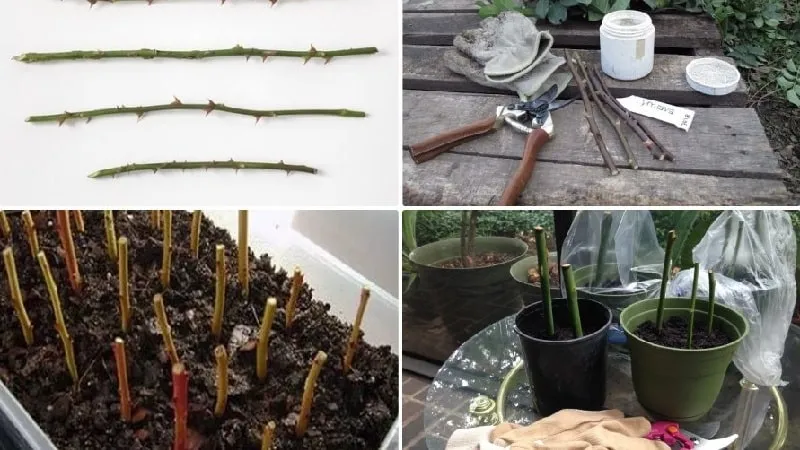
Aftercare
Roses love moisture, so water weekly (twice in droughts). Avoid overwatering to prevent root rot.
Fertilize with organic and mineral supplements, following dosage instructions. Apply on cloudy days with watering. A popular mix: 1 tbsp superphosphate, 30 g ash, 1.5 kg compost. Commercial options: "Miracle-Gro," "Doff," "Westland," "Levington."
For lush blooms, use yeast: 1 kg per 10 L warm water. Dilute 1:10 before use (1 L per bush). Apply monthly.
Leave young bushes in beds over winter. Protect with burlap, straw, or dry leaves. Transplant in spring.
Stop care routines by late August to prepare plants for winter. Avoid fertilizing to prevent frost-sensitive new growth. Prune in mid-October, removing dead or diseased stems and spent flowers.
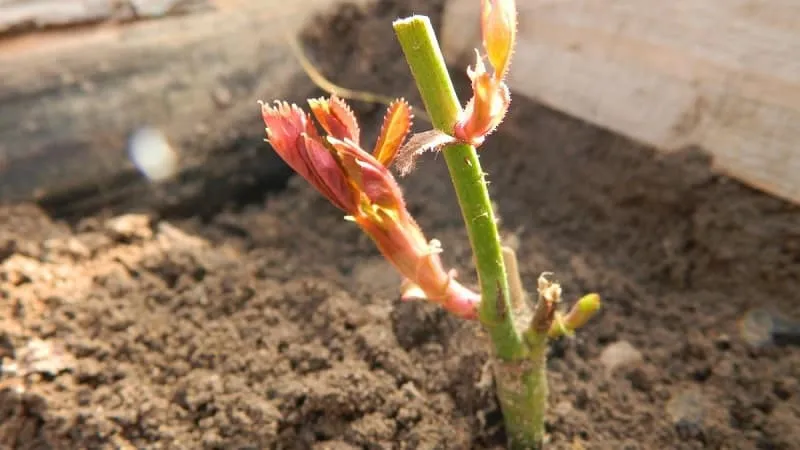
Tips from Experienced Gardeners
Follow these tips for thriving rose bushes:
- Trim dry, brown shoots on green cuttings diagonally to the first dormant bud.
- Dig holes deep enough to accommodate roots.
- Use only healthy green shoots with bud initials. Avoid old or diseased stems.
- Remove sickly roots and treat cuts with biofungicides like "Serenade" or "RootShield."
- Trim roots by 1.5-2 cm before planting to check for cream-colored, healthy cores.
- Remove wax from top cuts to allow growth.
- Soak cuttings in water for 2-3 hours before planting.
- Choose sloped planting sites (8-10° angle).
- Roses prefer slightly acidic soil (pH 5.5-6.5). Adjust with dolomite lime if needed (400-500 g per m²).
- Space plants 0.5-1 m apart to prevent fungal growth.
Conclusion
Summer cuttings preserve the qualities of bush and climbing roses while ensuring high survival rates. The best time is July – August during the waxing Moon. Rooting methods include water, soil, potatoes, plastic bags, burrito, and Trancault techniques.
Plant in fertile, shaded areas. Post-planting care involves moderate watering, fertilization, and soil aeration.







